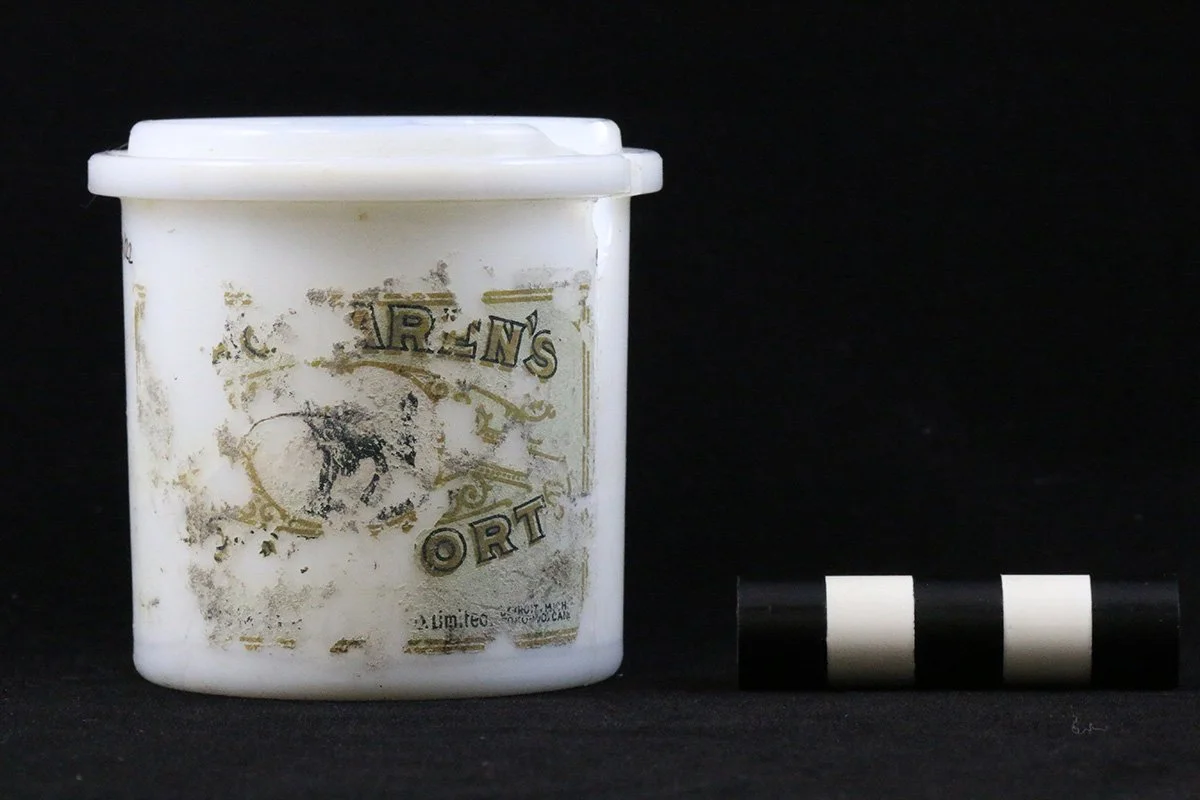
Products from the Fair
At the turn of the twentieth century, department stores and international expositions like the Chicago World’s Fair were two major factors boosting consumer culture.
Vienna Beef sausages were introduced by Austro-Hungarian Jewish immigrants Emil Reichel and Samuel Ladany at the 1893 Chicago Fair. From Arnold and Higinbotham 1893: 107).
Cream of Wheat cereal made its debut at the Fair and relied on racist depictions on of Black men in their branding.
James Keiller and Sons Dundee Marmalade jar.
MacLaren’s Imperial Cheese Company Roquefort cheese recovered from the 2015 Charnley-Persky House Archaeological Project, EU 4, ctx 22. Photograph by Ryan J. Cook.
An advertisement for AbilenA Natural Cathartic Water.
The base of a bottle of AbilenA Cathartic water from the 2010 excavation at the Charnley-Persky House Archaeological Project, EU 1 cleaning. Photograph by Ryan J. Cook.
Advertisement for Johann Hoff’s Malt Extract from 1898 (Kennebec (Maine) Daily Journal, 12 November: 3).
World’s Fair As Marketplace
“Fairs were venues within which to display the growing and changing material world. Serving an overt cultural mission with their architecture, art, and technological innovation, they can be understood as pedagogical moments for many Americans, teaching them what and how to consume, and to what end” (Graff 2020:22). Through viewing and consuming the mass-produced goods exhibited there, consumers received an education in the ruling ideology: “the necessity for expanding empires and building markets; the proper comportment for the working class; and ways to understand race and to racialize difference” (Graff 2020:121). At the same time, viewing and consuming these goods chosen to reflect the “dominant group material culture” gave visitors the opportunity “to cross class and status lines (e.g., Fitts 1999), racial boundaries (e.g., Mullins 1999), ethnic categories (e.g., Voss 2005), or all of the above” (Graff 2020:121). The choice of what to see and what to buy—and the connections that could be created between consumers, goods, social relations, and ideologies by that choice—confirm that shopping is meaningful action as well as economic behavior (Cook, Yamin, and McCarthy 1996).
Thus it is not a coincidence that “[f]airs visually resemble department stores, and department stores look like fairs. They have, it seems, an almost symbiotic relationship. At the 1855 Paris Exposition Universelle, goods on display were marked with visible price tags, making clear the path from observer to consumer. Tourists to the 1893 Chicago exposition received information about the fair at the department stores in Chicago’s Loop, and guidebooks to the fair were full of advertisements from area department stores (Lewis 1983:41; see Heckel 1893). Department stores, like expositions, shaped tastes, created consumers, and generated urban markets through entertaining and spectacular display (Lewis 1983)” (Graff 2020:129).
There were many products that debuted or entered the larger, national marketplace at the 1893 Chicago Fair that remain part of our American culinary landscape today. These famously include, but are not limited to Vienna Beef hot dogs, Wrigley Juicy Fruit gum, Cracker Jack (one version), Pabst Blue Ribbon beer (the use of its blue ribbon design apocryphally originates at the Chicago Fair), Aunt Jemima Pancake Mix (renamed Pearl Milling Company, as of 2021), and Cream of Wheat cereal. It is important to note, as discussed in other parts of this exhibit, Aunt Jemima Pancakes, as well as Cream of Wheat, relied on racist depictions of Black men and women in their branding.
World’s Fair Products and Archaeology
Because world’s fairs were such good venues for showcasing new and exciting products, it is not unexpected to have recovered the remains of many products that debuted at world’s fairs at the Charnley-Persky House. The following are some of these products unearthed during the archaeological excavations at the Charnley-Persky House in 2010 and 2015. Note that, although not all of them debuted at the 1893 Chicago Fair, they were definitely eaten or drunk in Chicago!
James Keiller and Sons Dundee Marmalade
First produced in 1797, Keiller marmalade’s success helped James Keiller and Sons become one of the largest confectioners in the UK. The company first used the name James Keiller & Son in 1827, and its marmalade is still available today. The product received awards at expositions in London (1862) and in Vienna (1873), which were eventually featured on the product’s packaging to further advertise its quality. This jar was one of several recovered from the Charnley-Persky House excavations.
MacClaren's Roquefort Cheese
This milk glass container held Maclaren’s Roquefort Cheese, made in Canada. Alexander Ferguson MacLaren established his company in 1891, selling it to Kraft in 1920. “…MacLaren not only showed his products at the Chicago fair but also served as a judge of the fair’s dairy products (Roberts and Tunnell 1910:143). Perhaps unsurprisingly, MacLaren’s cheese received a perfect score at the Chicago fair, which it then touted on post-1893 product labels (MacLaren’s Imperial Cheese Co. 1904)” (Graff 2020:125-126).
AbilenA Natural Cathartic Water
This mineral water from Abilene, Kansas, was held to have laxative properties. The company moved from Kansas to Chicago in 1919. The product was prominently displayed in Kansas' mineral exhibit at the 1904 St. Louis Exposition.
Johann Hoff Malt Extract
Although its name suggests that it might be beer, this malt product was a patent medicine, and received a medal and great acclaim at the 1893 World's Fair. Said to contain iron and other elements, this “nutritive tonic” boasted in advertising that it “exalts the energies, stimulates nutrition and aids digestion.” As depicted in the 1898 advertisement on this page, the product was also marketed to women who likewise wished to improve their appetite and digestion.
< Previous Page | Next Page >







